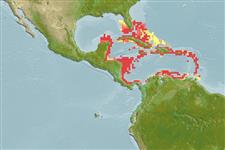Common names from other countries
Environment: milieu / climate zone / depth range / distribution range
Ecologie
marien; diepte 0 - 50 m (Ref. 189). Tropical; 28°N - 7°S, 90°W - 60°W (Ref. 189)
Western Central Atlantic: southern Florida (USA), Cuba, Bahamas, Greater and Lesser Antilles, and Yucatan, Mexico to Venezuela; not in Gulf of Mexico; Trinidad south to Guianas; possibly Brazil.
Grootte / Gewicht / Leeftijd
Maturity: Lm ? range ? - ? cm
Max length : 12.2 cm SL mannelijk / geslacht onbekend; (Ref. 130066); common length : 10.0 cm TL mannelijk / geslacht onbekend; (Ref. 5217)
Dorsale stekels (totaal) : 0; Dorsale zachte stralen (totaal) : 14 - 15; Anale stekels: 0; Anale zachte stralen: 19 - 26. Somewhat compressed. Snout pointed, about 3/4 eye diameter; maxilla pointed, long, reaching to hind border of pre-operculum; walkeri-type gill cover canals. Anal fin origin below about midpoint of dorsal fin base. Anus advanced, nearer to pelvic fin tips than to anal fin origin. Silver stripe along flank with a dark line above, expanded over anal fin, about 3/4 eye diameter (Ref. 189). Back gray, top of head iridescent. Melanophores evenly scattered on back, forming a middorsal line, especially rearward (Ref. 7251).
Occurs in coastal waters, forming dense schools. Not entering the mangrove-lined lagoons of the Venezuelan mainland, but is the dominant species of the Los Roques Archipelago off Venezuela and there found as much in the lagoons as outside them. Frequently caught in mixed schools (with A. mitchilli) in the Miami area. Feeds on zooplankton. Ripe females recorded off Florida in June and July. More data needed.
Levenscyclus en paargedrag
Maturities | Voortplanting | Spawnings | Egg(s) | Fecundities | Larven
Spawn in school (Ref. 205).
Whitehead, P.J.P., G.J. Nelson and T. Wongratana, 1988. FAO Species Catalogue. Vol. 7. Clupeoid fishes of the world (Suborder Clupeoidei). An annotated and illustrated catalogue of the herrings, sardines, pilchards, sprats, shads, anchovies and wolf-herrings. FAO Fish. Synop. 125(7/2):305-579. Rome: FAO. (Ref. 189)
Status op de Rode Lijst van het IUCN (Ref. 130435)
CITES (Ref. 128078)
Not Evaluated
Gevaar voor de mens
Harmless
Gebruik door de mens
Visserij: visserij voor eigen gebruik; aas: usually
Tools
Speciale rapporten
Download XML
Internetbronnen
Estimates based on models
Preferred temperature (Ref.
115969): 25.1 - 28.1, mean 27.5 (based on 112 cells).
Fylogenetische diversiteitsindex (Ref.
82804): PD
50 = 0.5000 [Uniqueness, from 0.5 = low to 2.0 = high].
Bayesian length-weight: a=0.00513 (0.00232 - 0.01135), b=3.14 (2.96 - 3.32), in cm Total Length, based on LWR estimates for this Genus-body shape (Ref.
93245).
Trofisch niveau (Ref.
69278): 3.4 ±0.45 se; based on food items.
Weerstandsvermogen (Ref.
120179): Hoog, minimale populatieverdubbelingstijd minder dan 15 maanden (Preliminary K or Fecundity.).
Fishing Vulnerability (Ref.
59153): Low vulnerability (10 of 100).
